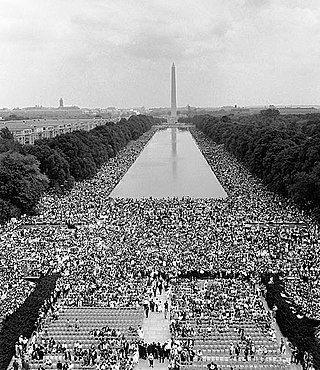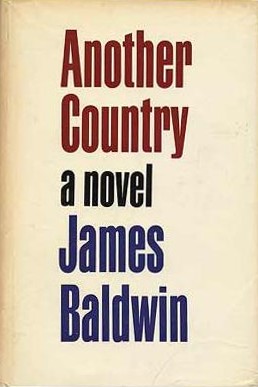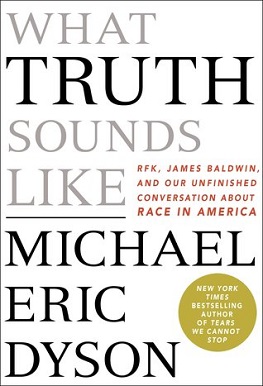
Harry Belafonte was an American singer, actor, and civil rights activist who popularized calypso music with international audiences in the 1950s and 1960s. Belafonte's career breakthrough album Calypso (1956) was the first million-selling LP by a single artist.

Medgar Wiley Evers was an American civil rights activist and the NAACP's first field secretary in Mississippi. He was assassinated by Byron De La Beckwith.

James Arthur Baldwin was an American writer and civil rights activist who garnered acclaim for his essays, novels, plays, and poems. His 1953 novel Go Tell It on the Mountain has been ranked among the best English-language novels. His 1955 essay collection Notes of a Native Son helped establish his reputation as a voice for human equality. Baldwin was a well-known public figure and orator, especially during the civil rights movement in the United States.

The March on Washington for Jobs and Freedom, also known as simply the March on Washington or the Great March on Washington, was held in Washington, D.C., on August 28, 1963. The purpose of the march was to advocate for the civil and economic rights of African Americans. At the march, final speaker Dr. Martin Luther King Jr., standing in front of the Lincoln Memorial, delivered his historic "I Have a Dream" speech in which he called for an end to racism and racial segregation.

Lena Mary Calhoun Horne was an American singer, actress, dancer, and civil rights activist. Horne's career spanned more than seventy years, appearing in film, television, and theatre. Horne joined the chorus of the Cotton Club at the age of sixteen and became a nightclub performer before moving on to Hollywood and Broadway.

Lorraine Vivian Hansberry was an American playwright and writer. She was the first African-American female author to have a play performed on Broadway. Her best-known work, the play A Raisin in the Sun, highlights the lives of black Americans in Chicago living under racial segregation. The title of the play was taken from the poem "Harlem" by Langston Hughes: "What happens to a dream deferred? Does it dry up like a raisin in the sun?" At the age of 29, she won the New York Drama Critics' Circle Award — making her the first African-American dramatist, the fifth woman, and the youngest playwright to do so. Hansberry's family had struggled against segregation, challenging a restrictive covenant in the 1940 U.S. Supreme Court case Hansberry v. Lee.

Raiford Chatman "Ossie" Davis was an American actor, director, writer, and activist. He was married to Ruby Dee, with whom he frequently performed, until his death. He received numerous accolades including a Grammy Award and a Writers Guild of America Award as well as nominations for five Emmy Awards, a Golden Globe Award, and Tony Award. Davis was inducted into the American Theater Hall of Fame in 1994 and received the National Medal of Arts in 1995, Kennedy Center Honors in 2004

Another Country is a 1962 novel by James Baldwin. The novel is primarily set in Greenwich Village, Harlem, and France in the late 1950s. It portrayed many themes that were taboo at the time of its release, including bisexuality, interracial couples, and extramarital affairs.

The Fire Next Time is a 1963 non-fiction book by James Baldwin, containing two essays: "My Dungeon Shook: Letter to my Nephew on the One Hundredth Anniversary of the Emancipation" and "Down at the Cross: Letter from a Region of My Mind".

Beauford Delaney was an American modernist painter. He is remembered for his work with the Harlem Renaissance in the 1930s and 1940s, as well as his later works in abstract expressionism following his move to Paris in the 1950s. Beauford's younger brother, Joseph, was also a noted painter.
James "Osie" Johnson was a jazz drummer, arranger and singer.

Jay Berliner is an American guitarist who has worked with Harry Belafonte, Ron Carter, Charles Mingus, and Van Morrison, among others.

The Stand in the Schoolhouse Door took place at Foster Auditorium at the University of Alabama on June 11, 1963. George Wallace, the Governor of Alabama, in a symbolic attempt to keep his inaugural promise of "segregation now, segregation tomorrow, segregation forever" and stop the desegregation of schools, stood at the door of the auditorium as if to block the entry of two African American students: Vivian Malone and James Hood.
Freedomways was the leading African-American theoretical, political and cultural journal of the 1960s–1980s. It began publishing in 1961 and ceased in 1985.

The Baldwin–Kennedy meeting of May 24, 1963 was an attempt to improve race relations in the United States. Attorney General Robert F. Kennedy invited novelist James Baldwin, along with a large group of cultural leaders, to meet Kennedy in an apartment in New York City. The meeting became antagonistic and the group reached no consensus. The black delegation generally felt that Kennedy did not understand the full extent of racism in the United States. Ultimately the meeting demonstrated the urgency of the racial situation and was a positive turning point in Kennedy's attitude towards the Civil Rights Movement.

Billie Allen was an American actress, theater director, dancer and entertainer. Allen was one of the first black actors and performers to appear on television and stage in the United States, at a time when those venues were largely closed to African Americans. During the 1950s, Allen became one of the first black entertainers to have a recurring role on network television when she was cast as a WAC on staff on the CBS army base comedy The Phil Silvers Show, from 1955 to 1959. She was one of the first African Americans to appear on television commercials in the U.S. She was also one of the earliest African-American actors on daytime soap operas as she appeared in the mid-1950s as the character Ada Chandler on the popular daytime soap opera The Edge of Night. Allen was also known for her work on Broadway and off-Broadway.

I Am Not Your Negro is a 2016 German-American documentary film and social critique film essay directed by Raoul Peck, based on James Baldwin's unfinished manuscript Remember This House. Narrated by actor Samuel L. Jackson, the film explores the history of racism in the United States through Baldwin's recollections of civil rights leaders Medgar Evers, Malcolm X and Martin Luther King Jr., as well as his personal observations of American history. It was nominated for Best Documentary Feature at the 89th Academy Awards and won the BAFTA Award for Best Documentary.

What Truth Sounds Like: Robert F. Kennedy, James Baldwin, and Our Unfinished Conversation About Race in America is a 2018 non-fiction book by Michael Eric Dyson.

Freedom was a monthly newspaper focused on African-American issues published from 1950 to 1955. The publication was associated primarily with the internationally renowned singer, actor and then officially disfavored activist Paul Robeson, whose column, with his photograph, ran on most of its front pages. Freedom's motto was: "Where one is enslaved, all are in chains!" The newspaper has been described as "the most visible African American Left cultural institution during the early 1950s." In another characterization, "Freedom paper was basically an attempt by a small group of black activists, most of them Communists, to provide Robeson with a base in Harlem and a means of reaching his public... The paper offered more coverage of the labor movement than nearly any other publication, particularly of the left-led unions that were expelled from the CIO in the late 1940s... [It] encouraged its African American readership to identify its struggles with anti-colonial movements in Africa, Asia, and the Caribbean. Freedom gave extensive publicity to... the struggle against apartheid."















